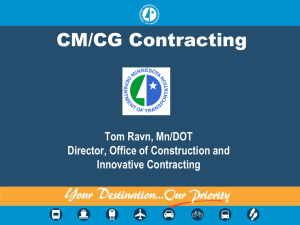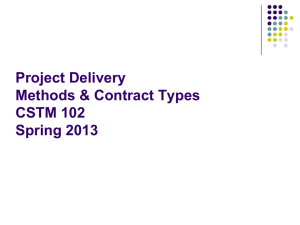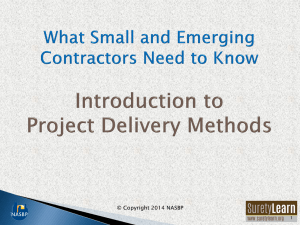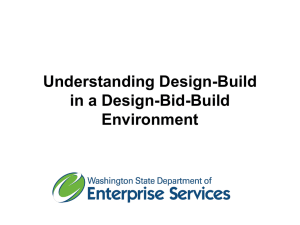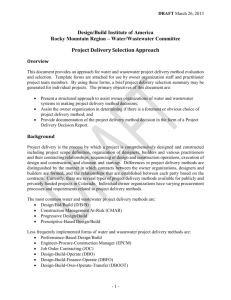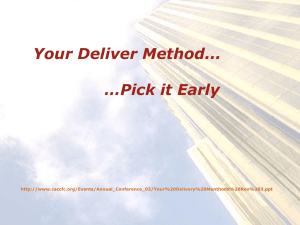Document
advertisement
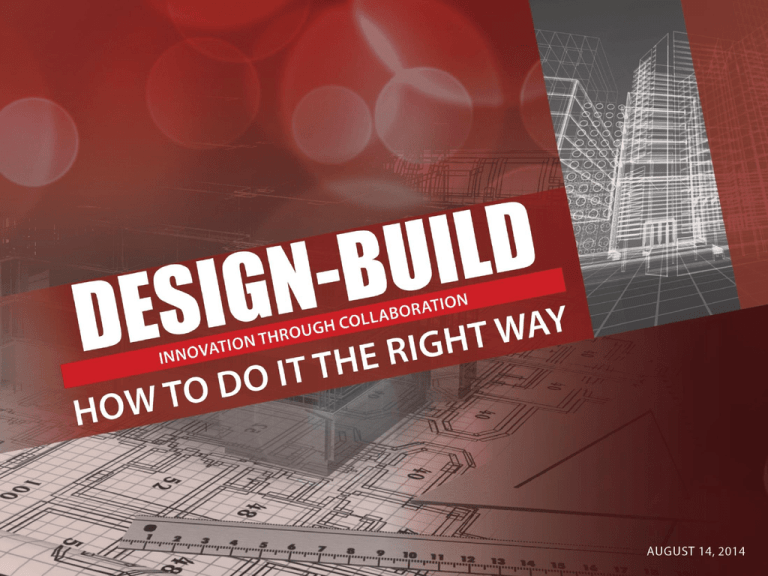
Your Presenters Lisa Dal Gallo Partner, LEED AP ldalgallo@hansonbridgett.com Dave Kirn Regional Executive/Justice Market Leader dkirn@kitchell.com Selecting the Right Project Delivery Available Delivery Models – Design-Bid-Build – Construction Manager at Risk (CMAR) – Design-Build – P3 DESIGN-BID-BUILD No early Separate contracts involvement of key for design & team members construction Construction Must award to Documents lowest bidder complete before advertisement for bids Construction Manager at Risk (CMAR) Allows for early involvement of CM CM selected based on lowest bid or best value Separate contracts for design & construction CM must be a licensed contractor Subcontractors awarded based on “process set forth by County” Design-Build Allows for early involvement of key project team members DB team selected based on lump sum or best value Single contract for design & construction DB must be a licensed contractor Can include key consultants and subcontractors as part of design-build team Project Delivery Method – Market Share Design Build – Market Size Design-Bid-Build Feedback Cycle Contractor Architect Consultants Program Re-Program Design Re-Design Trade Contractors Test Phase Long Delay Effect of Delayed Feedback • Design Effort Wasted • Design/Project Schedule Extended • Options Constrained • Upward Drift in Project Cost Design-Bid-Build Feedback in Design-Build Projects Design/Builder Design/Builder GC + Architect Consultants & Key Subs Test Test Test • Continuous Cost Data • Rapid Estimation (BIM) Key Subcontractors • From Engaged Contractors Project Delivery Comparison Integration CMAR Design Bid Build Early Contract Owner Contractor Project Management Possible BIM LEAN No Involvement Design Build Owner CM Architect CM or PM Contractor Contractor Likely BIM LEAN CM Architect Owner CM DB CM or PM CMAR CM D/B Contractor Cost Control Lump Sum Lump Sum or GMP Target Cost GMP Lump Sum Subs Lump Sum Lump Sum Generally Lump Sum GMP for Key Subs Risk Contractor Cost/Schedule Risk Architect (E & O) CMAR Cost/Schedule Risk Architect (E & O) DB Contractor has Cost/Schedule Risk and most liability Risk Advantages of Design-Build One stop shop for owner Increase collaboration & innovation Increased efficiency Decreased change orders Increased sustainability Eliminates finger pointing between contractor and A/E Disadvantages Designers of record and contractor on same team Prequalification process can extend contract award process Owner does not pick A/E directly Criteria/Bridging A/E cannot propose on design-build team Goals / Reasons For Using Design Build Value based selection Selecting a partner – Collaboration – Innovation Reduced owner risk – Single point of responsibility – Reduction of claims, delays and change orders Flexibility in process Performance guarantees Achieving Your Project Goals Finding The Right Advisors – Legal Counsel – Project/Construction Manager – Criteria/Bridging Architect Determining The Right DB Strategy Strategies available – Best Value – Lump Sum Design competitions Stipends – Why pay a stipend – How to determine the amount of the stipend How far to take the criteria/bridging documents Develop DB Agreement To Achieve Project Objectives Deal Point Summary – Project objectives and goals – Compensation – Project management – Communication flow – Change orders – Dispute resolution process – Project charter/teaming agreement Team Composition Skills – Technical expertise – Problem solving/decision skills – Interpersonal skills Diversity – Experience & knowledge – Creative tension Size (5-9) – Small = efficient = 4 or 5 – Large = creative <=12 – Smallest team necessary Personality – Collaboration (1/3 not collaborative) – Command and control – Firm culture Team Organization Cross-functional teams Interdisciplinary – Systems or areas Discrete whole – Cost, scope and responsibility Design, construction, cost, schedule, commissioning Duration Dependent on function Package work to teams, not teams to work Teams within teams External or internal coordination Team Agreement Mission Statement Value Statement – What is most important to team Behaviors – Process & strategy Measurable Goals – Value – Goals – Target – Metric Communications Teams – Leadership – Cross-functional DBE Selection– A Two-Step Process Step 1 - RFQ/Pre-Qualifications – Process – Establishing requirements – Scoring SOQ’s – Shortlisting (5-6 teams) – Interview proposed teams – Notice to qualified proposers • At least 3 and no more than 5 DBE Selection (Continued) Step 2 – RFP – – – – RFP must be clear and concise Define the process Confidential meetings Evaluation/scoring of proposals • Evaluation criteria • Weighting of evaluation criteria • Criteria compliance – Interviews – Selection – Award Criteria Compliance Log - Sample Facilitating Design Process Basis of Design – Proposal presented to all stakeholders Program Verification – Owner/stakeholder involvement Systems Confirmation – Conformance with criteria Target Value Design Process “Construction Documents” Quality Control Design Quality – Design issues log – Requests for clarification – Requests for information – Design reviews Construction Quality – Submittal reviews • Action • Information Design Issues Log - Sample Quality Control Inspection & Testing – Inspector of Record – Testing & Inspection Start-up & Testing Punch-list Commissioning & Acceptance Commissioning – Compliance with criteria Beneficial Occupancy Full Occupancy Transition Plan Warranties & Guarantees
